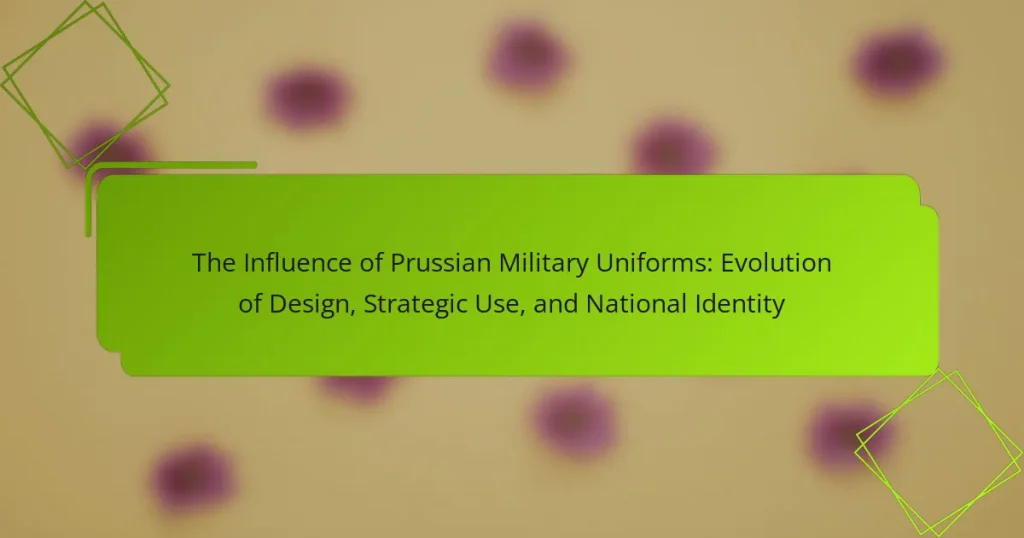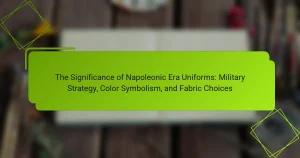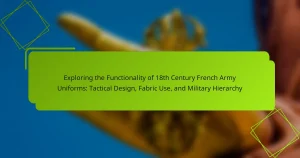Prussian military uniforms are characterized by their distinctive colors, materials, and designs, primarily featuring dark blue or black as base colors, brass buttons, and unique insignia indicating rank and unit affiliation. These uniforms, made from high-quality wool, combined functionality with visual appeal, incorporating elements such as the tailcoat style and the iconic pickelhaube helmet. The evolution of these uniforms during the 19th century reflects the Prussian military’s systematic approach to design, emphasizing uniformity and discipline, which significantly influenced military dress codes globally. The effectiveness of Prussian uniforms was particularly evident during the Franco-Prussian War, where they contributed to a strong national identity and showcased the interplay between military attire, social hierarchy, and military strategy. Understanding these aspects offers valuable insights into the evolution of military practices and the role of visual identity in warfare.
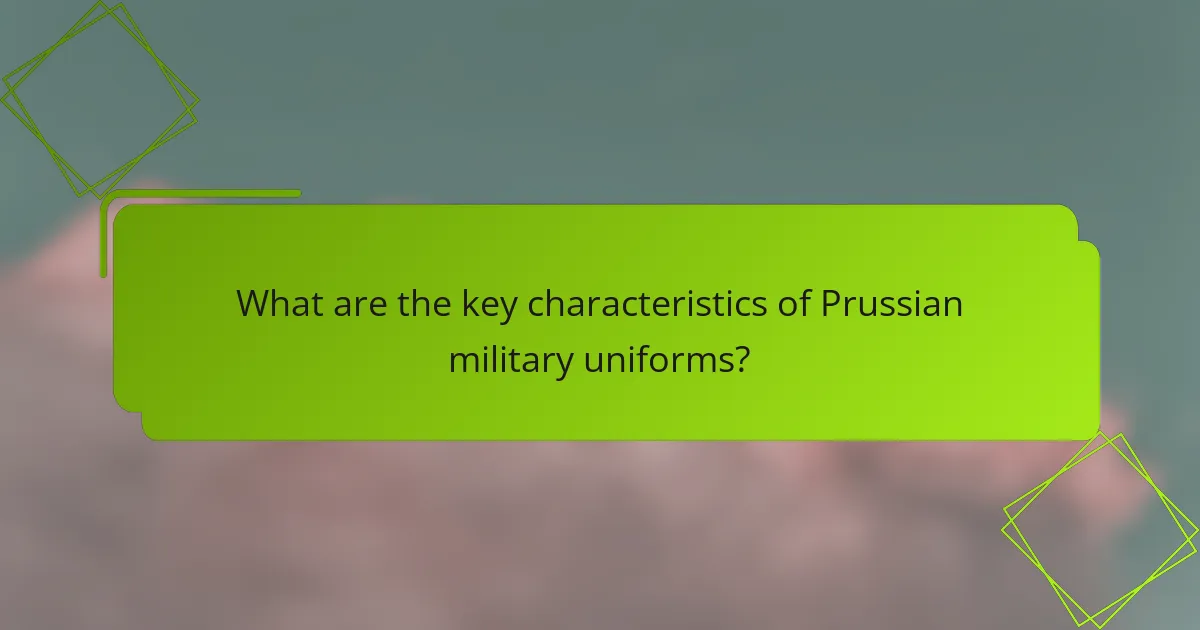
What are the key characteristics of Prussian military uniforms?
Prussian military uniforms are characterized by their distinctive colors, materials, and designs. They typically featured a dark blue or black base color, which was a hallmark of the Prussian army. The uniforms often included brass buttons and distinctive insignia that denoted rank and unit affiliation. Prussian uniforms were made from high-quality wool, providing durability and warmth. The design often incorporated a tailcoat style, which was both practical and formal. Additionally, uniforms included elements such as epaulettes, which indicated rank, and a unique pickelhaube helmet, symbolizing the Prussian military. These characteristics contributed to a sense of discipline and national pride within the ranks. The uniforms evolved over time, reflecting changes in military strategy and national identity.
How did the design of Prussian military uniforms evolve over time?
The design of Prussian military uniforms evolved significantly from the 17th century to the 19th century. Initially, uniforms were colorful and ornate, reflecting the baroque style of the time. By the late 18th century, practicality became a priority, leading to simpler designs. The introduction of the “Pickelhaube” helmet in the 1840s became a distinctive feature. The uniforms transitioned to a more standardized look, emphasizing functionality and military efficiency. The use of dark blue as the primary color emerged, symbolizing discipline and unity. During the 19th century, the influence of military reforms further streamlined uniform design. These changes reflected broader shifts in military strategy and national identity. The evolution of these uniforms marked a significant transformation in how military forces were perceived and represented.
What historical events influenced the changes in uniform design?
The changes in uniform design were influenced by several historical events. The Napoleonic Wars prompted nations to reevaluate military attire for practicality and morale. The introduction of the rifle necessitated more functional designs, moving away from heavy fabric. The Industrial Revolution facilitated mass production of uniforms, leading to standardized designs. World War I saw the adoption of khaki and camouflage for better concealment. The rise of nationalism influenced uniform aesthetics, reflecting national identities. Additionally, technological advancements in fabric and materials led to innovations in uniform design. Each of these events contributed significantly to the evolution of military uniforms.
Which materials and colors were commonly used in Prussian military uniforms?
Prussian military uniforms commonly used wool and cotton as primary materials. These fabrics provided durability and comfort for soldiers. The colors predominantly featured were dark blue and gray. Dark blue was often associated with the Prussian army’s identity. Gray was used for various regiments, reflecting a practical choice for field use. Historical records indicate that these color choices helped establish a recognizable military presence. The combination of materials and colors contributed to the uniforms’ effectiveness and the army’s overall image.
What role did Prussian military uniforms play in shaping national identity?
Prussian military uniforms significantly contributed to shaping national identity. These uniforms became symbols of discipline and order, reflecting the values of the Prussian state. The distinctive design elements, such as the pickelhaube helmet, fostered a sense of pride among soldiers and civilians alike. During the 19th century, uniforms were central to military parades, reinforcing national unity. They served as a visual representation of the strength and organization of the Prussian military. The use of specific colors and insignia further distinguished the Prussian identity from other nations. By the late 19th century, these uniforms were iconic, influencing military attire across Europe. The association of uniforms with national achievements solidified their role in the collective memory of the nation.
How did uniforms symbolize the values and ideals of Prussian society?
Uniforms symbolized the values and ideals of Prussian society by embodying discipline, order, and national pride. The distinct designs reflected a commitment to military excellence. Prussian uniforms often featured precise tailoring and distinctive colors, which represented unity and professionalism. The use of uniforms fostered a sense of belonging among soldiers, reinforcing loyalty to the state. Additionally, uniforms served as a visible representation of the Prussian military’s power and effectiveness. Historical events, such as the victories in the wars of German unification, further solidified the role of uniforms in promoting Prussian ideals. The emphasis on uniformity in appearance mirrored the societal values of hierarchy and structure. Ultimately, Prussian uniforms became a powerful symbol of national identity and cultural values.
In what ways did uniforms contribute to the perception of military power?
Uniforms significantly contributed to the perception of military power by establishing a visual identity. They created a sense of discipline and order among troops. The distinctive designs often instilled fear in opponents. Historical examples include the Prussian uniforms, which symbolized efficiency and strength. Uniforms also fostered a sense of unity and camaraderie within the ranks. They served as a tool for propaganda, projecting an image of invincibility. The colors and insignia used were strategically chosen to enhance recognition. Overall, uniforms played a crucial role in shaping public perception of military might.
What strategic purposes did Prussian military uniforms serve?
Prussian military uniforms served multiple strategic purposes. They were designed to enhance discipline and unity among troops. The distinct colors and patterns fostered a sense of identity and pride. Uniforms also facilitated recognition on the battlefield. This recognition was crucial for maintaining order during combat. Additionally, uniforms provided practical benefits, such as protection and functionality. The use of specific materials helped in durability and comfort. Historical evidence shows that these uniforms contributed to the effectiveness of Prussian military strategies. The visual impact of these uniforms also played a role in psychological warfare against enemies.
How did uniform design enhance battlefield effectiveness?
Uniform design enhanced battlefield effectiveness by improving soldier visibility and cohesion. Distinctive uniforms helped units identify each other quickly. This reduced friendly fire incidents during chaotic engagements. Additionally, uniforms provided psychological advantages. Well-designed attire instilled confidence and discipline among troops. Historical examples include the Prussian military, which utilized uniforms to create a unified national identity. The distinctive blue and gold uniforms of the Prussian army became symbols of their strength. Enhanced functionality, such as pockets and durable fabrics, also contributed to operational efficiency. Overall, uniform design played a crucial role in organization, morale, and effectiveness on the battlefield.
What psychological impacts did uniforms have on soldiers and enemies?
Uniforms had significant psychological impacts on both soldiers and enemies. For soldiers, uniforms fostered a sense of unity and belonging. They enhanced morale and discipline among troops. This was particularly evident in the Prussian military, where distinctive uniforms symbolized national pride. Soldiers felt empowered and more willing to fight under a recognizable banner.
For enemies, uniforms served as a psychological tool of intimidation. The sight of organized, uniformed troops could instill fear and uncertainty. Historical accounts indicate that well-uniformed forces often had a psychological advantage in battle. The visual impact of uniforms could demoralize opposing troops, making them feel outmatched.
In summary, uniforms influenced group identity and cohesion for soldiers. They also acted as a psychological weapon against enemies. The effects of uniforms in warfare are well-documented in military history.
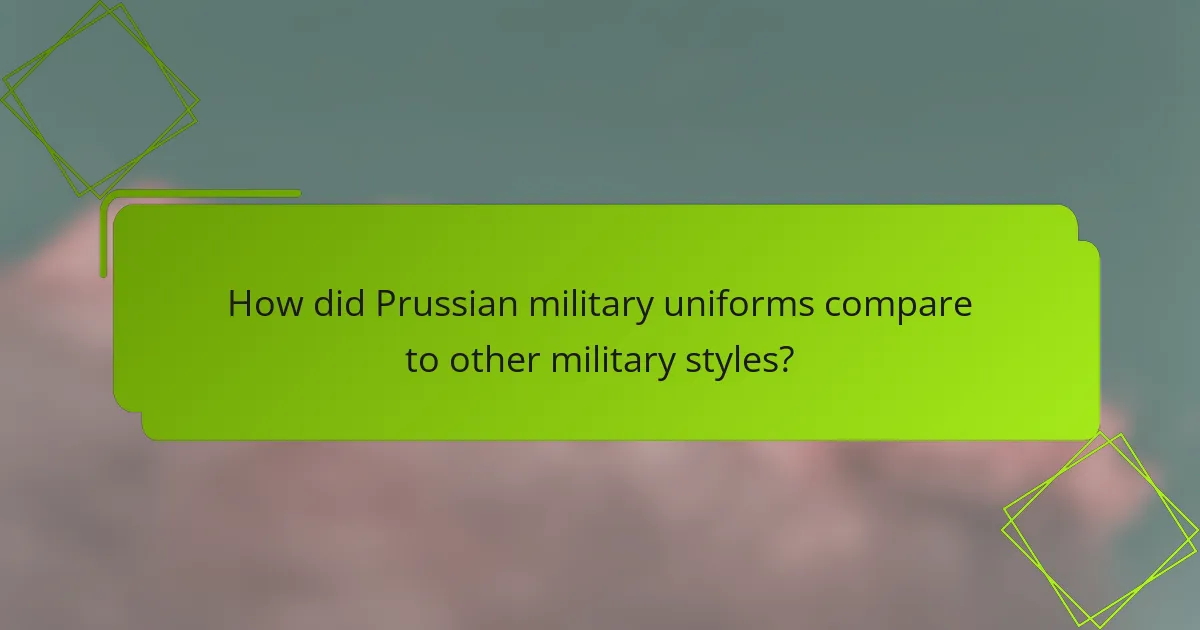
How did Prussian military uniforms compare to other military styles?
Prussian military uniforms were distinctively tailored and often more elaborate than those of other military styles. They featured a unique combination of functionality and visual appeal, emphasizing discipline and order. The use of bold colors, such as the iconic dark blue and bright brass buttons, set them apart from the drab uniforms of contemporaneous armies. Prussian uniforms were also designed for ease of movement, incorporating practical elements like tailored cuts and durable fabrics.
Historically, the Prussian military adopted a more systematic approach to uniform design during the 19th century, reflecting the growing influence of military professionalism. This was in contrast to other nations, which often prioritized tradition over functionality. The Prussian emphasis on uniformity and regimentation influenced military dress codes in various countries, leading to a broader adoption of similar styles.
The effectiveness of Prussian uniforms was evident in their role during the Franco-Prussian War of 1870-71, where their distinct appearance contributed to a strong national identity. Overall, Prussian military uniforms combined aesthetic appeal with practical design, setting a standard that influenced military attire worldwide.
What were the distinctive features of Prussian uniforms versus other nations?
Prussian uniforms featured distinct characteristics that set them apart from those of other nations. They often included a dark blue color, which became synonymous with the Prussian military. The use of high collars and distinctive headgear, such as the pickelhaube (spiked helmet), was also notable. Prussian uniforms emphasized functionality and discipline, reflecting the military’s organizational structure.
Additionally, the cut of the uniforms was tailored to allow ease of movement. Prussian officers frequently wore elaborate decorations and insignia that denoted rank and unit. The adoption of specific materials, like wool and leather, contributed to the durability of the uniforms.
These features not only served practical purposes but also symbolized national pride and military prowess. The Prussian military’s influence on uniform design extended to other nations, shaping military aesthetics globally.
How did international conflicts influence uniform design across countries?
International conflicts significantly influenced uniform design across countries by necessitating adaptations for functionality and symbolism. The need for camouflage and protection during warfare led to the adoption of more practical materials and colors. Historical examples include the transition from bright red British uniforms to khaki during the Second Boer War. This shift was driven by the need for soldiers to blend into their environments.
Additionally, conflicts often resulted in the standardization of uniforms within armies to foster unity and national identity. For instance, the Prussian military reforms after the Napoleonic Wars emphasized discipline and uniformity. These changes influenced other nations to adopt similar designs for their own forces.
Moreover, international conflicts spurred technological advancements in uniform design. Innovations such as lighter fabrics and improved tailoring emerged to enhance soldier mobility. Overall, the interplay between warfare and uniform design reflects evolving military strategies and national identities shaped by historical events.
What adaptations were made by other militaries inspired by Prussian uniforms?
Many militaries adapted their uniforms by incorporating elements inspired by Prussian designs. The British Army adopted the dark blue tunic and introduced the use of epaulettes. The French Army modified its uniform to include a more streamlined silhouette and adopted the use of a shako hat influenced by Prussian headgear. The Russian military adopted the Prussian-style high-collared tunics and introduced similar insignia designs. Other nations, such as Austria and Italy, also embraced the Prussian color schemes and fitted designs to modernize their military appearance. These adaptations reflected a broader trend of military modernization influenced by Prussian efficiency and discipline.
What legacy did Prussian military uniforms leave on modern military attire?
Prussian military uniforms significantly influenced modern military attire through their design and functionality. Their use of distinct colors, such as blue and gray, became a standard in many armies. The adoption of structured, tailored fits improved soldier mobility and comfort. Prussian uniforms also popularized the use of insignia and rank badges, enhancing identification and hierarchy. The iconic pickelhaube helmet influenced headgear designs worldwide. Furthermore, the emphasis on discipline and uniformity in Prussian attire set a precedent for military organization. This legacy is evident in the uniforms of contemporary armed forces, which often reflect these historical influences.
How are elements of Prussian design reflected in contemporary uniforms?
Elements of Prussian design are reflected in contemporary uniforms through structured tailoring and distinctive insignia. The Prussian military emphasized precision in fit and functionality. This focus on tailored cuts is evident in modern military and formal uniforms. Additionally, the use of bold colors and unique insignia can be traced back to Prussian traditions. For example, the dark blue and gold combinations originated from Prussian regalia. These design choices enhance identity and cohesion within units today. The legacy of Prussian design continues to influence military aesthetics globally.
What lessons can modern militaries learn from the evolution of Prussian uniforms?
Modern militaries can learn the importance of functionality and symbolism from the evolution of Prussian uniforms. Prussian uniforms were designed for both practicality in combat and representation of national identity. The use of distinctive colors and insignia fostered unit cohesion and morale among soldiers. Additionally, the adoption of innovative materials improved soldier comfort and performance. Historical analysis shows that Prussian uniforms influenced military dress across Europe, emphasizing the role of uniforms in establishing a military’s image. This evolution highlights the need for modern militaries to balance tradition with modern advancements in fabric technology and design. Ultimately, the lessons from Prussian uniforms can guide contemporary forces in enhancing operational effectiveness and national pride.
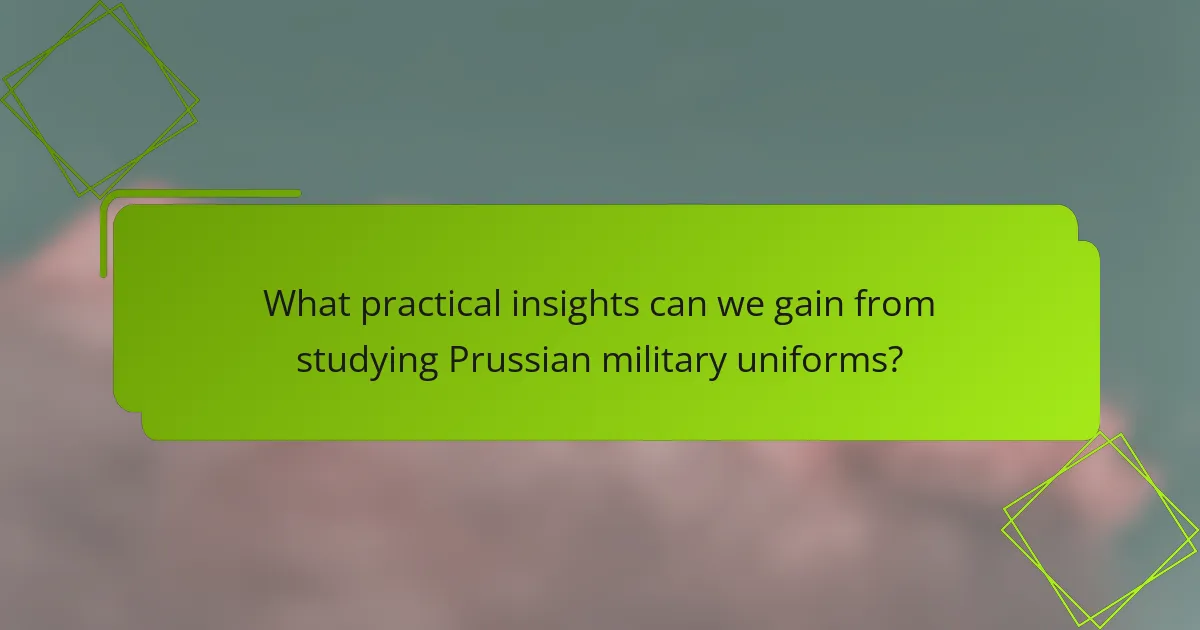
What practical insights can we gain from studying Prussian military uniforms?
Studying Prussian military uniforms provides insights into military strategy, social hierarchy, and national identity. The design of these uniforms reflects the evolution of military tactics and technology. For example, the introduction of the Pickelhaube helmet in the 19th century symbolized Prussian militarism and authority. Analyzing uniform colors and insignia reveals the importance of visual identity in warfare. The uniforms also illustrate the role of fashion in military culture and its impact on morale. Historical records indicate that uniform changes often coincided with shifts in military doctrine. Understanding these aspects informs contemporary military practices and design considerations.
How can the history of Prussian military uniforms inform current design practices?
The history of Prussian military uniforms can inform current design practices by illustrating the importance of functionality and symbolism. Prussian uniforms were designed for both practical military use and to convey national identity. The use of distinct colors and insignia helped establish a sense of unity and purpose among soldiers.
Current designers can draw inspiration from these principles by integrating functionality into modern uniforms. This includes considering materials that enhance performance while also reflecting cultural significance. Additionally, the historical emphasis on discipline and order in Prussian uniforms can guide contemporary approaches to uniform design in various fields.
By studying the evolution of Prussian uniforms, designers can understand how aesthetics and practicality coexist. This historical context provides a framework for creating uniforms that are not only visually appealing but also serve the intended purpose effectively.
What best practices can be derived from the strategic use of military uniforms?
Best practices derived from the strategic use of military uniforms include the establishment of clear identity and cohesion among troops. Military uniforms serve to unify personnel, fostering a sense of belonging and team spirit. They also enhance discipline, as standardized attire promotes adherence to military protocols. Additionally, uniforms can be designed for functionality, ensuring that they meet operational needs such as camouflage and protection. Historical examples show that effective uniform design can boost morale and instill pride. The Prussian military, for instance, utilized distinctive uniforms to create a recognizable national identity. This strategic use of uniforms has been shown to influence both internal cohesion and external perception.
How can understanding the cultural significance of uniforms enhance military branding?
Understanding the cultural significance of uniforms can enhance military branding by creating a strong identity and fostering connection. Uniforms symbolize discipline, unity, and tradition. They evoke historical narratives and national pride. For instance, the Prussian military uniforms are linked to the emergence of a national identity in Germany. This connection can strengthen public perception and trust in the military. Research shows that well-designed uniforms can improve morale and cohesion among troops, further enhancing the brand’s image. Effective branding through uniforms can also influence recruitment and public support.
The main entity of the article is Prussian military uniforms, which are analyzed for their evolution in design, strategic use, and role in shaping national identity. The article details key characteristics such as color, materials, and distinctive elements like the pickelhaube helmet, as well as how historical events influenced uniform design. It explores the psychological impacts of uniforms on soldiers and enemies, the practical insights gained from their study, and their lasting legacy on modern military attire. Additionally, it discusses how understanding the cultural significance of uniforms can enhance military branding and cohesion.
